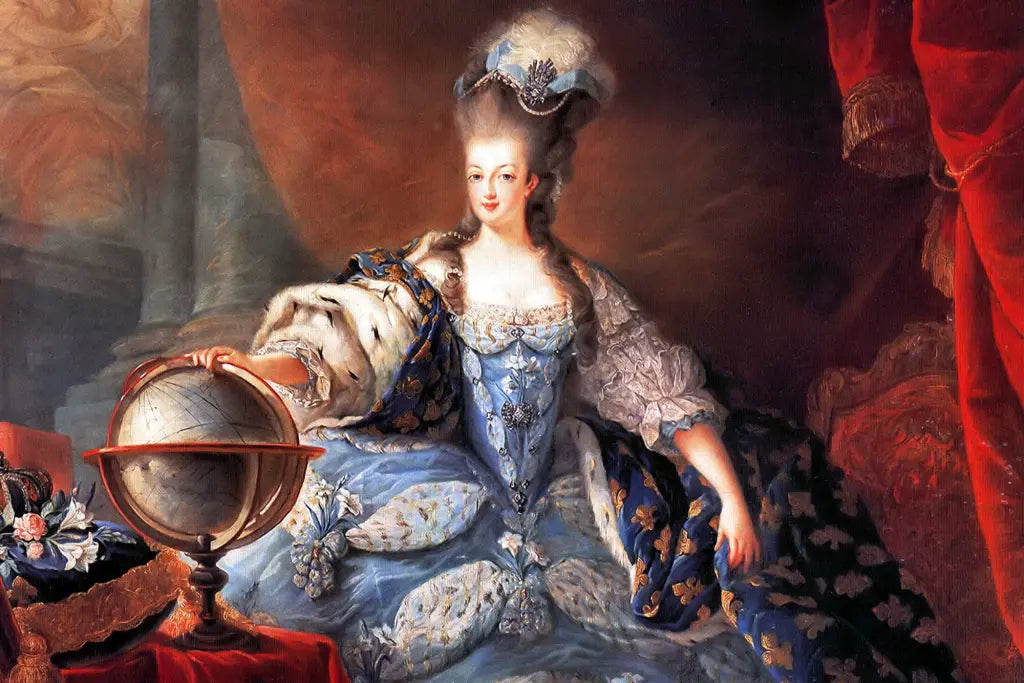Article Summary: At Versailles, perfume was power and Marie Antoinette ruled by scent. Her obsession with tuberose, the most forbidden flower of the 18th century, became both her signature and her scandal. Tuberose was said to make proper ladies faint and courtiers gossip, yet the Queen drenched herself in it anyway — from scented gloves to perfumed baths. This article explores how her love for the intoxicating white bloom became a quiet act of rebellion, the chemistry behind its addictive allure, and how ēma’s modern solid perfume revives that same daring elegance in a sleek, pocket-sized compact.
There are perfume lovers and then there was Marie Antoinette.
If you think your vanity is a little overstocked, imagine one that required its own servant.
The Queen of France didn’t simply wear perfume. She lived in it. Her perfumer, Jean-Louis Fargeon, documented years of royal scent requests so specific and lavish that even modern fragrance houses would blush. Bathwater infused with rose petals. Powdered gloves steeped in iris and amber. Hair pomade scented with orange blossom. And at the center of this cloud of luxury was one note that courtiers whispered about behind her back: tuberose.
The Most Scandalous Flower at Versailles
In 18th-century France, tuberose was no ordinary bloom.
Its white petals gave off a scent so rich, so intoxicating, that it was considered dangerous. Priests allegedly warned young women not to breathe too deeply near tuberose at night, lest it stir unseemly passions. The flower symbolized sensuality; beautiful, yes, but unrestrained, almost indecent.
Naturally, Marie Antoinette adored it.

Tuberose wasn’t ladylike in the soft, powdered way of violets or lilies. It was unapologetically heady, buttery, and carnal. Wearing it was a declaration: I will be noticed. It filled a room before she entered it and lingered long after she left.
And while others at court dabbed demure eau de fleurs on lace cuffs, Marie’s perfumer crafted custom blends so full of tuberose that one letter from the palace described her chambers as “a garden at midnight - impossible to breathe without feeling faint.”
Was it exaggeration? Possibly. But in a world of gossip and wigs that scraped the ceiling, exaggeration was half the fun.
Perfume as Power
At Versailles, scent wasn’t just vanity—it was strategy.
Perfume masked the stench of the palace (which, rumor has it, wasn’t exactly fragrant), but it also functioned as a calling card. Every aristocrat had a signature scent; if you could smell who’d passed through a hallway, you knew who held influence.
Marie Antoinette’s fragrance, rich with rose, jasmine, orange blossom, sandalwood, iris, and tuberose spoke volumes. It was elegance and rebellion, sweetness laced with danger. Fargeon’s blends were designed for secrecy: perfumes were made in tiny solid pastes or scented gloves that released fragrance with every gesture.
To shake someone’s hand at court wasn’t just a greeting, it was an olfactory introduction. Marie’s scent was unforgettable. Some said too unforgettable.

“Her Majesty’s scent arrives before she does,” one noblewoman is said to have murmured.
“She smells of a thousand lovers,” whispered another.
The Queen Who Smelled Too Good
Imagine being one of her ladies-in-waiting, balancing a mountain of powdered hair and lace, while your queen glided past leaving behind a wake of creamy tuberose. You’d either worship her, or talk about her.
“Her Majesty’s scent arrives before she does,” one noblewoman is said to have murmured.
“She smells of a thousand lovers,” whispered another.
The truth is less salacious but far more interesting. Marie Antoinette used perfume to escape the rigid life of the court. At her private retreat, the Petit Trianon, she surrounded herself with gardens - orange trees, violets, hyacinths, and fields of white tuberose that bloomed at dusk. The Queen was, quite literally, cultivating her freedom in scent.
When she couldn’t rule her country, she ruled her own air.

Tuberose’s intoxicating power isn’t just folklore—it’s chemistry.
The flower contains indoles, natural molecules that occur in both flowers and human skin. They give tuberose its almost animalic depth, that mix of sweetness and heat that feels both floral and forbidden. Combined with creamy lactones and hints of spice, the note becomes impossible to forget.
That’s why perfumers still chase its complexity centuries later. It’s the contradiction that makes it addictive: innocent petals hiding something darker underneath.
No wonder Marie Antoinette couldn’t resist it.
Escape, Captured in a Scent
When the Revolution began and the royal family fled Versailles, legend claims Marie Antoinette carried a small vial of her perfume. The blend has been reconstructed by historians as Sillage de la Reine, a lush combination of tuberose, jasmine, rose, iris, cedar, and sandalwood. Even in exile, she refused to live without beauty.
There’s something heartbreakingly human about that. The woman history painted as vain and frivolous was, perhaps, just clinging to the one sensory memory that still felt like herself. A single scent that held the echo of silk, laughter, and moonlit walks through her gardens at Trianon.
And that scent, of course, was tuberose.
That’s why perfumers still chase its complexity centuries later. It’s the contradiction that makes it addictive: innocent petals hiding something darker underneath.
No wonder Marie Antoinette couldn’t resist it.
Why Tuberose Still Matters
Tuberose has outlasted every trend because it embodies the paradox of true luxury: it’s beautiful, but it bites back. It doesn’t whisper; it purrs. And like the women who wear it, it’s capable of softness and power at the same time.
Marie Antoinette understood that before anyone else. Her perfumes weren’t about pleasing others; they were about asserting her presence in a world that constantly tried to define her.
So the next time you open your ēma compact, think of the Queen’s perfumed gloves, her scented fans, and the way gossip followed her through gilded corridors. Let your own scent trail behind you - a little rebellious, a little romantic, entirely unforgettable.

Long Live the Queen (and the Tuberose)
In the end, Marie Antoinette’s story isn’t about tragedy—it’s about taste. The power to choose what beauty means to you, even when the world disapproves. She chose flowers that spoke louder than politics.
And perhaps that’s why, three centuries later, we’re still talking about her—and still wearing her favorite bloom.
So here’s to tuberose: the forbidden flower that made history smell divine.




Share:
Fragrance Layering Guide: How to Create Your Own Signature Scent